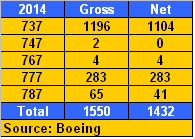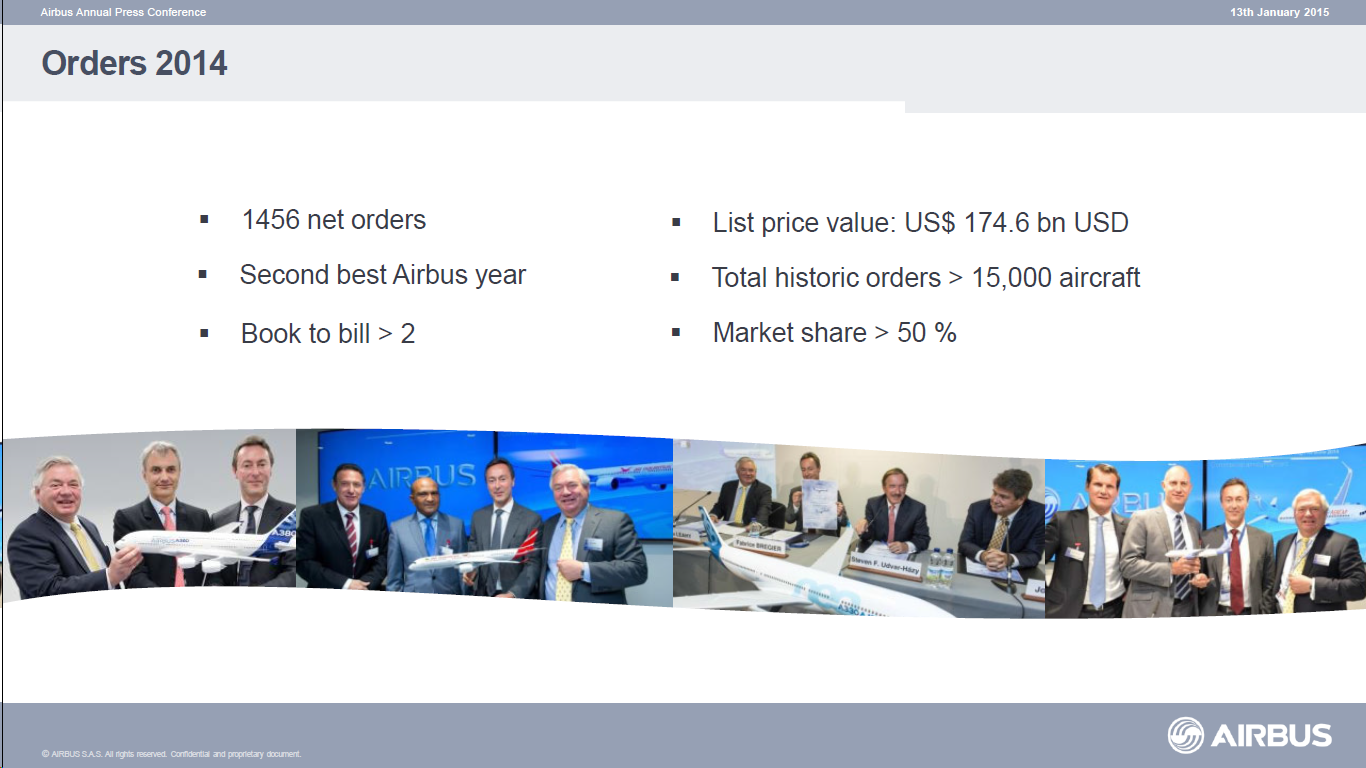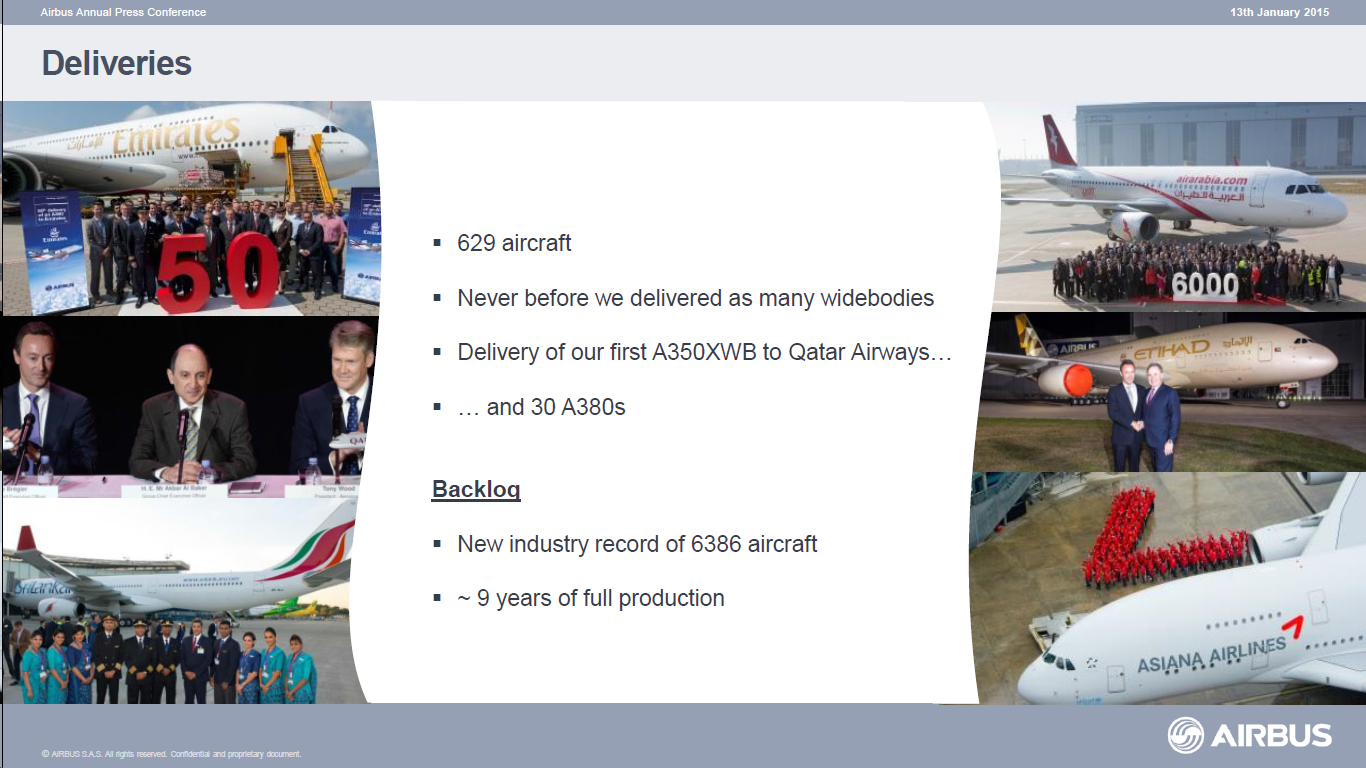Leeham News and Analysis
There's more to real news than a news release.
Boeing sees little impact from fuel on orders
Jan. 13, 2015: Boeing sees little impact on orders from the falling fuel prices.
In a tele-press conference this morning, Randy Tinseth, vice president of marketing, said recent history shows that even as fuel prices went down, the backlog of orders went up.
Oil is currently hovering around $46/bbl. The last time it was this low was 2008, after the global financial collapse. It took 2 1/2 years for oil prices to recover to around $100/bbl.
Airbus reveals record orders at annual press conference
By Bjorn Fehrm
Toulouse 13 Jan 2015: Airbus today held their annual press conference where they among other things revealed their final numbers for orders and deliveries. The press conference was hosted by Airbus CEO Fabrice Bregier accompanied by COO Customers John Leahy, new COO Tom Williams and new Head of Programs Didier Evrard.
Airbus in 2014
Bregier started with pointing out that 2014 was a very eventful year for Airbus. Airbus did their customary end of year sprint and passed Boeing for net orders with 24 aircraft netting 1456 commands, Figure 1.
On the delivery side Boeing is ahead with 723 deliveries versus Airbus 629, Figure 2.
Further Airbus certified the A350 and delivered the first aircraft to its launch customer, Qatar Airways. It also launched the A330neo and got 120 orders during the year. Finally they flew the A320neo first prototype.
A380neo decision likely this year, triggering the next widebody engine project
Subscription required
By Bjorn Fehrm
Introduction
Jan. 12, 2015: One of the subjects which is sure to come up on Airbus annual press conference on Tuesday the 13th in Toulouse will be when and how Airbus will re-engine the A380.
Airbus Commercial CEO Fabrice Bregier vowed during the Airbus Group Global Investors Day last month that an A380neo is coming.
There is much speculation around this subject as the business case of re-engineering an aircraft that is selling at such low numbers is difficult to get to close. The business case is difficult to make work for Airbus  (such a project will cost in the order of $2 billion) but it will be equally hard for the engine manufacturers to offer engines that have enough efficiency gain to make the overall project feasible from an efficiency improvement perspective.
(such a project will cost in the order of $2 billion) but it will be equally hard for the engine manufacturers to offer engines that have enough efficiency gain to make the overall project feasible from an efficiency improvement perspective.
Summary
- A380 Classic equals Boeing 777-300ER seat fuel costs.
- Boeing 777-9 beats A380 on CASM, an A380neo regains the advantage.
- Engine makers face hard choices to retain dominance or to broaden market penetration.
AirAsia 8501: two weeks later, still looking for the voice recorder
Jan. 11, 2015: It’s now been two weeks and two days (local time) since AirAsia Flight 8501 crashed into the Java Sea. It took nearly two weeks just to locate the tail section of the airplane, which was raised. The flight data recorder was recovered Jan. 12 local time but the cockpit voice recorder is still missing.
Greg Feith, a former crash investigator for the US National Transportation Safety Board, wrote Sunday on his Facebook page, “ADS-B data was used to narrow the search area for the main wreckage. Info from both black boxes will finally provide a factual foundation that the airplane likely ended up in a high speed descent, probably a spiral descent, and impacted the water in an out-of-control situation and not an attempted emergency landing. With the main wreckage scattered, the airplane likely broke-up and skipped across the surface. We should know soon as the info is developed and provided by the NTSC.”
Aging Boeing 757 engines skew operating expenses
Jan. 8, 2015: Engines on the aging fleet of Boeing 757s are a key reason operating costs of this rather unique airplane are between 20% and 30% more than a Boeing 737-9 or an Airbus A321neo.
“The thing to worry about most for the 757 engines is the cost to overhaul,” says an industry official who trades in 757s. “The cost of producing life limited parts is crippling the marketplace.”
Total costs and the direct operating costs are being directly affect by the engine costs, the person says, who doesn’t want to be identified because of the sensitivity of the topic.
Odds and Ends: 737 MAX order breakdown; Airbus to top Boeing; Embraer to PNAA event
Jan. 6, 2015: 737 MAX Orders: Boeing has broken down the 737 MAX orders for the entire program in response to our inquiry. The 737-8 has captured 87% of the program orders since launch in 2011. The MAX 8 includes the 100 MAX 200 orders for the high density version, placed by Ryanair last year. The MAX 9 has 11% and the MAX 7 just 2% (figures are rounded).
Airbus to top Boeing: It’s not really a surprise, because it seems to happen just about every year. Reuters is reporting that Airbus will top Boeing in gross and net orders when it reports its 2014 performance next week.
Embraer to PNAA: Embraer’s chief commercial officer, John Slattery, will speak at the Feb. 10-12 conference for the Pacific Northwest Aerospace Alliance. EMB has presented previously but this is the first time Slattery is joining the conference. Click on the banner ad above to go directly to the conference website.
Boeing 2014 orders: 1,550 gross, 1,432 net
Update, 8:45am PST: Boeing sent us this breakout of 777 and 737 orders:
777-300ER: 49
777 Freighter: 14
777X: 220
737 MAX: 891
Original Post:
Boeing received 1,550 gross orders and 1,432 net orders in 2014, one of its best years.
 As is typical, the narrow-body 737 was by far and away the leader in orders. Boeing doesn’t break out the 737NG v 737 MAX in its monthly table. The 777 was buoyed by firming up the massive number of 777X commitments announced at the Dubai Air Show in November 2013. Although Boeing doesn’t break out, in this table, the 777X v 777 Classic, the company ended the year with around 60 777 Classic orders, an important number to fill the production gap we and others have been writing about last year.
As is typical, the narrow-body 737 was by far and away the leader in orders. Boeing doesn’t break out the 737NG v 737 MAX in its monthly table. The 777 was buoyed by firming up the massive number of 777X commitments announced at the Dubai Air Show in November 2013. Although Boeing doesn’t break out, in this table, the 777X v 777 Classic, the company ended the year with around 60 777 Classic orders, an important number to fill the production gap we and others have been writing about last year.
The 767 commercial model continues to wind down, as the last ones off the line–all freighters–get delivered. The line will shift over to solely the USAF KC-46A once the 767Fs are delivered.
The 747-8 put in another dismal year, with two gross orders and two cancellations.
Boeing delivered 723 airplanes last year: 485 737s, 19 747s, 6 767s, 99 777s, 114 787s.
Reuters has this update of Airbus’ order position through November, in advance of the annual Airbus press conference on Jan. 13, where full year numbers will be announced. Airbus has a habit of finishing Decembers with a surge of orders, often topping the Boeing numbers.
Real time tracking, FDR transmission needs to happen now
As time passes following the Dec. 28 crash of AirAsia flight 8501, it has become even more apparent that the need for real time tracking of the position of a commercial flight and real time transmission of flight data recorder information is necessary.
The issues aren’t new. Airplanes have gone missing since the dawn of aviation. Real impetus began to pick up after the 2009 disappearance of Air France flight 447. This flight went down over the South Atlantic in proximity to major thunderstorms. Radar coverage indicated the flight track but not the final position. ACARS, the system monitoring the health of the aircraft’s systems, transmitted enough information so that the airline, investigators and Airbus had a reasonable picture of what happened but a picture that was incomplete. It took five days to locate the first debris and bodies in the water and two years to locate and retrieve the black boxes, which filled in the picture of a flight crew in complete befuddlement over what was happening to their airplane. The accident was entirely avoidable, and the circumstances incorporated into future training may well save lives.
Despite the delay in finding the airplane and black boxes, the airline industry and regulators did nothing to require real time tracking and data transmission.





